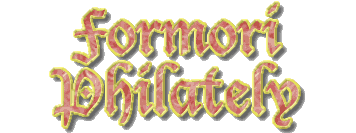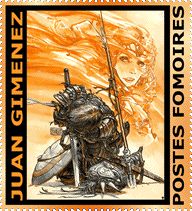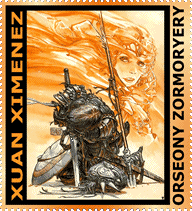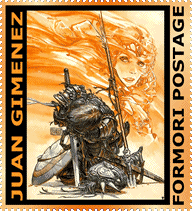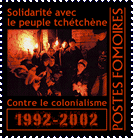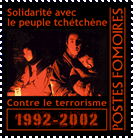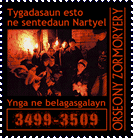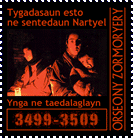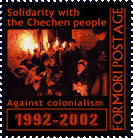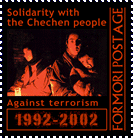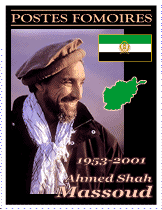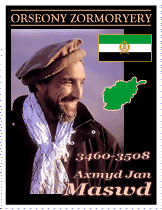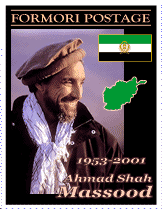Stamps of the Year 3509Although it has neither its own currency nor any proper postal service, during Summer 3508 (2001), the Formori Community decided to set up a philatelic service in charge of issueing commemorative stamps with no postage value. These 'e-stamps', designed only to be published as graphic files, are used mostly to add a 'Formori touch' to e-mails sent by the members of the community. No actual printing of these stamps is planned for any use outside of the Internet. How to use Formori e-stamps? The e-stamps shown in this section are free for use. To place them inside an e-mail, you can either download them on your hard drive and paste them in your e-mail as any other picture, or place a link to their location on this site directly within your message. In case of any problem, feel free to contact us . |
![]()
Series |
Topic |
||
![]()
![]()
3509-02 Series
|
A people of Northern Caucasus linked to Georgians and to Circassians (and thus remote cousins to the Basques), the Chechens (who call themselves the «Nakhtios») are the descendants of tribes of nomadic breeders who flew the Alains in the mountains. They were Islamized in the XVIIIth century (3200-3300), and conquered by the Russian Empire in 1859 (3366), at the end of the «murid wars». After a failed attempt to create a Republic of Northern Caucasus (with te peoples of the neighboring Daghestan) when the Empire collapsed, the Chechen ended up under Soviet control. Following a series of revolts in the 1930s and 1940s (3440-3450), Stalin decided to deport the whole population in February 1944 (3450), under the pretext that some collaborated with the German invaders when they reached the borders of Chechnya in November 1942 (3449) shortly before retiring in the wake of the Stalingrad defeat. Some 475,000 Chechens were sent to Siberia. The survivors were allowed to come back in 1957 (3464).
When the Soviet Union collapsed, the Chechens tried to restore their sovereignty by refusing to join the new Federation of Russia in March 1992 (3499) and by declaring their independence in October of the same year. Due to its oil resources and the pipe line that runs accross its territory, Chechnya was considered a major asset by the new Russia. To recover it, Russia imposed a blocked on the territory which shortly fell into chaos. As this policy proved useless, Russia sent its troops to invade Chechnya in December 1994 (3501). After almost three years of war, a peace agreement planning a refernedum in 2001 (3508) was signed on August 31, 1997 (3504) and the Russian troops retired.
With no recognition by the international community and no access for the non-government organizations, Chechnya fell under control of mafias which exploit and ransom the population. In September 1999 (3506), under the pretext of terrorist attacks imputed to the Chechens without any proof, the Russian government launched a new offensive on Chechnya. This new war enabled to establish in Moscow an authoritarian power held by the heirs of the former Soviet Nomenklatura. During these two conflicts, 10 to 15% of the civilian Chechen population was killed.
Today, the Chechens are caught in a crossfire between an authoritarian Russia leading a colonial war and implementing a policy of ethnic cleansing - it does not hesitate to close refugee camps to send back helpless civilians in the ruins of their villages at the beginning of winter - and warlords, often tied to Caucasian and even Russian mafias, who conduct pillaging and acts of terrorism.
This trilingual series (French, English and Formori), issued in support to the Chechen people is illustrated by two photographs of refugees hiding from Russian bombardments in a dugout, taken in 1995-1996 (3502-3503) by Shinichi Murata, and reminds the major revendications of this people: neither colonialism, nor terrorism.
![]()
3509-01 Series
|
On the day of Water, in the month of the Path of the year of the Sparrowhawk (September 9, 2001), Ahmad Shah Massood, the"Tiger of Pansheer", was murdered by false Moroccan journalists. This murder was only a prelude to the crisis that engulfed the whole planet two days later with the terrorist attcks against the World Trade Center in New York.
The commandant Massood, an early resistant to the Soviet invasion of Afghanistan in 3486 (1979) and then to the fanatic regime of the Talibans, could not see the international coalition intervening in his country and try to restore a democratic regime. As a supporter of a moderate islam, who was able to hold his head high against all fanatisms which engulfed its country, he was an incarnation of hope. We honor his memory so that this hope will never die, for those who beleive and fight for a better world.
This trilingual series (French, English and Formori), issued in the honor of commandant Massood, is illustrated by a photograph stamped with the Northern Alliance flag - the national flag of Afghanistan from 3499 (1992) to 3503 (1996) - and an outline map of the country which uses the same green as the flag, both the color of islam and of hope.
